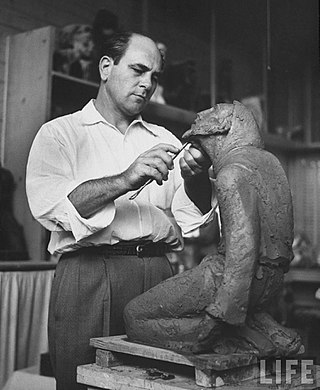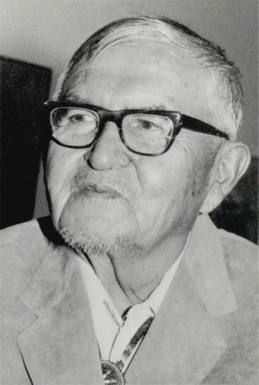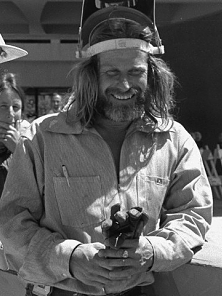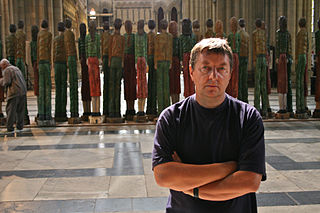
Duane Hanson was an American artist and sculptor born in Minnesota. He spent most of his career in South Florida. He was known for his life-sized realistic sculptures of people. He cast the works based on human models in various materials, including polyester resin, fiberglass, Bondo, and bronze. Hanson's works are in the permanent collections of The Whitney Museum of American Art, The San Francisco Museum of Modern Art, and The Smithsonian.

Leonard Baskin was an American sculptor, draughtsman and graphic artist, as well as founder of the Gehenna Press (1942–2000). One of America's first fine arts presses, it went on to become "one of the most important and comprehensive art presses of the world", often featuring the work of celebrated poets, such as Sylvia Plath, Ted Hughes, Anthony Hecht, and James Baldwin side by side with Baskin's bold, stark, energetic and often dramatic black-and-white prints. Called a "Sculptor of Stark Memorials" by the New York Times, Baskin is also known for his wood, limestone, bronze, and large-scale woodblock prints, which ranged from naturalistic to fanciful, and were frequently grotesque, featuring bloated figures or humans merging with animals. "His monumental bronze sculpture, The Funeral Cortege, graces the Franklin Delano Roosevelt Memorial in Washington, D.C."

Charles Umlauf was an American sculptor and teacher who was born in South Haven, Michigan. His sculptures can be found in churches, numerous public institutions, outdoor locations, and museums, including the Houston Museum of Fine Arts, the Smithsonian Institution in Washington, D.C, and the Metropolitan Museum of Art in New York, as well as in many private collections. Umlauf received a number of accolades, including a Guggenheim Fellowship and a Ford Foundation Grant.

The Umlauf Sculpture Garden & Museum, stylized as the UMLAUF, is a museum and outdoor sculpture garden centered on the artistic works of American sculptor Charles Umlauf. Located at 605 Azie Morton Road in the Zilker neighborhood of Austin, Texas, the garden is adjacent to Austin's Zilker Park.

Allan Capron Houser or Haozous was a Chiricahua Apache sculptor, painter, and book illustrator born in Oklahoma. He was one of the most renowned Native American painters and Modernist sculptors of the 20th century.

Marco Polo di Suvero, better known as Mark di Suvero, is an abstract expressionist sculptor and 2010 National Medal of Arts recipient.
Luis Alfonso JiménezJr. was an American sculptor and graphic artist of Mexican descent who identified as a Chicano. He was known for portraying Mexican, Southwestern, Hispanic-American, and general themes in his public commissions, some of which are site specific. The most famous of these is Blue Mustang. Jiménez died in an industrial accident during its construction. It was commissioned by the Denver International Airport and completed after his death.
The Bay Area Figurative Movement was a mid-20th-century art movement made up of a group of artists in the San Francisco Bay Area who abandoned working in the prevailing style of Abstract Expressionism in favor of a return to figuration in painting during the 1950s and onward into the 1960s.
Philip Grausman is an American sculptor, known for his portrait works.

Manuel John Neri Jr. was an American sculptor who is recognized for his life-size figurative sculptures in plaster, bronze, and marble. In Neri's work with the figure, he conveys an emotional inner state that is revealed through body language and gesture. Since 1965 his studio was in Benicia, California; in 1981 he purchased a studio in Carrara, Italy, for working in marble. Over four decades, beginning in the early 1970s, Neri worked primarily with the same model, Mary Julia Klimenko, creating drawings and sculptures that merge contemporary concerns with Modernist sculptural forms.

Ken Dawson Little is a modernist San Antonio-based sculptor who was born in Canyon, Texas in 1947. After graduating from Texas Tech University in 1970 with a BFA in painting, he received an MFA from the University of Utah in 1972. There, his interest in painting waned in favor of ceramics. In 1988, he settled in San Antonio, Texas, and his interests shifted to bronze animal masks. Little later shifted to steel sculpture, animal forms constructed from discarded shoes and human forms decoupaged with American paper money. Fury, in the collection of the Honolulu Museum of Art is an example of this stage in the artist's work. He has been a professor of art at the University of Texas at San Antonio since 1988.

Ho Baron is a surrealist sculptor living and working in El Paso, Texas. His controversial pieces have been featured in shows, galleries, museums and public art installations in Arizona, California, Colorado, Illinois, Maryland, Nevada, New Hampshire, New Mexico, New York, Ohio, Oklahoma, Texas, Virginia, Washington and Mexico.

James Arthur Surls is an American modernist artist and educator, known for his large sculptures. He founded the Lawndale Alternative Arts Space at the University of Houston in the 1970s.
Lester Johnson was an American artist and educator. Johnson was a member of the Second Generation of the New York School during the late 1950s. The subject of much of his work is the human figure. His style is considered by critics and art historians to be in the figurative expressionist mode.

Scott Myers is an American painter and sculptor who lives and works in Texas. He graduated Texas A&M University in 1984 with a doctorate in veterinary medicine. He studied sculpture throughout Italy focusing on Florence, Venice and Rome. Sculpting in Tuscany, he cast his work in bronze at the prestigious Fonderia d'Arte Massimo Del Chiaro in Pietrasanta. In 1994, Myers became an elected member of the National Sculpture Society. On February 12, 2011, Myers was featured in the popular television show Texas Country Reporter. Myers was inducted in the inaugural class of the Haltom City High School Hall of Fame on March 10, 2011.

Robert Koenig was an English sculptor based in Sussex, who specialised in wood sculpture and was a prominent exponent of the art of woodcarving using the traditional tools of mallet and chisel. He was known for his carved and polychromed figurative wood sculptures, which he had been creating since the early 1980s. One of the earliest polychromed figures was shown in the 'Temple' exhibition at the Shaw Theatre, London in 1988.

Ryder Richards is an American artist, writer, and curator. He works in the field of conceptual art, critical theory, and installation. His art practice consists of several bodies of work, often researching cultural violence, conspiracy voids and architectural influence. He has participated in several collaborative art groups.
Sedrick Ervin Huckaby (1975) is an American artist known for his use of thick, impasto paint to create murals that evoke traditional quilts and his production of large portraits that represent his personal history through images of family members and neighbors.
William Page Reimann is an American sculptor and arts educator, known for his large plexiglas and steel sculptures, stonework, metalwork, and figurative graphite and ink drawings. He was among the handful of "pioneering" sculptors who brought plastic materials to the New York art scene in the 1960s. In stone, his notable public works include the Radnor Gateway Project for the Blue Route in Radnor, PA, and the twenty-four granite panel series of the Piers Park Commons Pavilion in East Boston, MA.
Irene Pijoan was a Swiss-born American painter, sculptor, and educator. She was active in the San Francisco Bay Area and taught at the San Francisco Art Institute for more than 20 years.












